microPAM analysis#
This notebook contains a program to read and plot the microPAM data.
Python environment#
# setup environment
import os
import glob
import numpy as np
import matplotlib as mpl
import matplotlib.pyplot as plt
import matplotlib.dates as dates
import scipy.signal as signal
import sounddevice as sd
from numba import jit
from datetime import datetime, timedelta
print("Date and time is:", datetime.now())
plt.rc('font', size=15)
mpl.rcParams['figure.figsize'] = (10,5)
Date and time is: 2025-02-25 16:31:07.213027
General utilities#
@jit(nopython=True,cache=True)
def quadInt(uu,imx,nd1,nc):
ux=np.zeros((nc,2))
for ii in range(nc):
uo=uu[imx[ii],ii]
um=uu[imx[ii]-1,ii]
up=uu[imx[ii]+1,ii]
b=(up+um-2*uo)/2;
xo=(um-up)/(4*b);
yo=uo-b*xo**2;
xo += imx[ii]-nd1;
ux[ii,0]=xo
ux[ii,1]=yo
return ux
@jit(nopython=True,cache=True)
def TKO(x):
y=0*x
y[1:-1,:]= x[1:-1,:]*x[1:-1,:]-x[:-2,:]*x[2:,:]
return y
def mcmap(ncol=256):
# https://stackoverflow.com/questions/49367144/modify-matplotlib-colormap
# create a colormap that consists of
# - 1/5 : custom colormap, ranging from white to the first color of the colormap
# - 4/5 : existing colormap
# set upper part: 4 * 256/4 entries
upper = mpl.cm.jet(np.arange(ncol))
# set lower part: 1 * 256/4 entries
# - initialize all entries to 1 to make sure that the alpha channel (4th column) is 1
lower = np.ones((int(ncol/4),4))
# - modify the first three columns (RGB):
# range linearly between white (1,1,1) and the first color of the upper colormap
for i in range(3):
lower[:,i] = np.linspace(1, upper[0,i], lower.shape[0])
# combine parts of colormap
cmap = np.vstack(( lower, upper ))
# convert to matplotlib colormap
cmap = mpl.colors.ListedColormap(cmap, name='mcmap', N=cmap.shape[0])
return cmap
def mDir(root,hh,f):
# find file in path
return glob.glob(root+hh+"_"+str(f[0])+'%02d'%f[1]+'%02d'%f[2]+
'\\%02d'%f[3]+
'\\F_%02d'%f[3]+'%02d*.bin'%f[4])
def printHex(x,nb=32):
if nb==16:
with np.printoptions(formatter={'int':'{:04x}'.format}): print(x)
if nb==32:
with np.printoptions(formatter={'int':'{:08x}'.format}): print(x)
microPAM support functions#
#
#-----------------------------------------------------------------------------------
def loadData(fileName):
xx = np.fromfile(fileName, dtype='uint32')
vers=xx[5]
SerNum=xx[6]
fs = xx[7] # sampling frequency
nch = xx[8] # number of channels
cp = xx[12] # data compress mode
sh = xx[13] # shift in bits
recTimeStamp=(xx[1:5].tobytes()).decode()
return xx,nch,fs,cp,sh,vers,SerNum,recTimeStamp
#
#--------------------------------------------------------
@jit(nopython=True,cache=True)
def decodeBlock(out,inp,nd,nb,NX):
""" unpack ILAC data block"""
kk=0
nx=NX
for ii in range(nd):
nx -= nb
if nx>0:
out[ii] = inp[kk]>>nx
elif nx==0:
out[ii] = inp[kk]
kk += 1
nx=NX
elif nx <0:
out[ii] = inp[kk] << (-nx)
kk += 1
nx += NX
out[ii] |= (inp[kk]>>nx)
#
@jit(nopython=True,cache=True)
def decode32(yy,nch,nsamp):
""" decode ILAC int32 data """
nblock=nch*nsamp
tmp=np.zeros(nblock,dtype='uint32')
for ii in range(yy.shape[0]):
# relevant header info
header=yy[ii,:6].copy()
nc=header[4] & 0xffff
nd=header[5] & 0xffff
nb=header[1] & 0xffff
sh=header[1] >>16
# keep first sample
inp0=yy[ii,6:(6+nch)].copy()
# ddata
inp=yy[ii,6+nch:].copy()
#
NX=32
decodeBlock(tmp,inp,nblock,nb,NX)
# sign bit
nb1=np.uint32(1<<(nb-1))
sgn=(tmp & nb1)>0
# mask
nb2=np.int32(1<<nb)
msk=np.uint32(nb2-1)
tmp = tmp & msk
# reconstruct uncompressed data
tmpi=tmp.astype('int32')
tmpi[sgn] = tmpi[sgn]-nb2
tmpi[:nch] = inp0[:nch].astype('int32')
for jj in range(nch,nblock):
tmpi[jj] = tmpi[jj] + tmpi[jj-nch]
# store in matrix
#tmpi = tmpi<<sh
yy[ii,:] = tmpi.astype('uint32')
return yy.astype('int32')
@jit(nopython=True,cache=True)
def decode16(yy,nch,nsamp):
""" decode int16 ILAC data"""
nblock=nch*nsamp
yyx=np.zeros(yy.shape,dtype='int16')
tmp=np.zeros(nblock,dtype='uint16')
for ii in range(yy.shape[0]):
# relevant header info
nc=yy[ii,4] & 0xffff # should be nch
nd=yy[ii,5] & 0xffff # number of compressed data
nb=yy[ii,1] & 0xffff
sh=np.int16(yy[ii,1] >>16)
# keep first sample
yy16 = yy[ii,6:].astype('uint16')
inp0 = yy16[:nch].copy()
# decode
inp=yy16[nch:]
NX=16
decodeBlock(tmp,inp,nblock,nb,NX)
# sign bit
nb1=np.uint16(1<<(nb-1))
sgn=(tmp & nb1)>0
# mask
nb2=np.uint16(1<<nb)
msk=np.uint16(nb2-1)
tmp = tmp & msk
# reconstruct uncompressed data
tmpi=tmp.astype('int16')
tmpi[sgn] = tmpi[sgn]-nb2
tmpi[:nch] = inp0[:nch].astype('int16')
for jj in range(nch,nblock):
tmpi[jj] = tmpi[jj] + tmpi[jj-nch]
#tmpi = tmpi<<sh # not working in old data
# store in matrix
yyx[ii,:] = tmpi
return yyx
@jit(nopython=True,cache=True)
def decodeInit(xx,nch,nsamp):
""" prepare ILAC data decoding
accummulate compressed blocks in a matrix"""
nblock=nch*nsamp
# search data key words
id0=np.where(xx==0xa5a5a5a5)[0]
nd=xx[id0+5]
nd1=nd&0xffff
nd2=nd>>16
#
# check type of storage (all-in-one, or split)
ndx = (nd2==0)
ndy = ((nd1[1:]+nd1[:-1])==nd2[1:]) & (nd2[1:]==nd2[:-1])
# prepare set of blocks to be decode
nblocks=np.sum(ndx)+np.sum(ndy)
yy=np.zeros((nblocks,nblock),dtype='uint32')
kk=0
j1=0
if ndx[0]:
for jj in range(nd1[0]+6): yy[kk,jj] = xx[id0[0]+jj]
kk +=1
for ii in range(1,len(ndx)-1):
if ndx[ii]:
for jj in range(nd1[ii]+6): yy[kk,jj] = xx[id0[ii]+jj]
kk +=1
if ndy[ii]:
for j1 in range(nd1[ii]+6): yy[kk,j1] = xx[id0[ii]+j1]
if ndy[ii-1]:
j1=nd1[ii-1]+6
for j2 in range(nd1[ii]): yy[kk,j1+j2] = xx[id0[ii]+6+j2]
yy[kk,5]=yy[kk,5]>>16
kk +=1
if ndx[-1]:
for jj in range(nd1[-1]+6): yy[kk,jj] = xx[id0[-1]+jj]
kk +=1
#
return yy
#
#
def loadAcoustics(fileName):
""" load microPAM acoustic data (bin or wav)"""
#print(fileName[-4:])
if fileName[-4:]=='.bin':
# decode ILAC (Integer Lossless Audio Compression)
xx,nch,fs,cp,sh,vers,SerNum,recTimeStamp = loadData(fileName)
print(vers)
#
yy=decodeInit(xx,nch,128)
t1=yy[:,2].copy()
t2=yy[:,3].copy()
to=t1[0]+(t2[0]%1000000)/1000000
#
if (vers<10) | vers>=20:
dat=decode32(yy,nch,128)
sc=1/2**(31-sh)
else:
dat=decode16(yy,nch,128)
sc=1/2**(15-0*sh)
#
dat=dat.reshape(-1,nch).astype('float')*sc
td=to+np.arange(dat.shape[0])/fs
return td,dat,fs,SerNum,recTimeStamp
#
if fileName[-4:]=='.wav':
xx = np.fromfile(fileName, dtype='uint32')
nch=xx[5]>>16
fs=xx[6]
nbits=xx[8]>>16
chunk=xx[9].tobytes().decode()
if chunk=='data':
SerNum=0
recTimeStamp=''
to=0
datx=xx[11:]
elif chunk=='info':
SerNum = xx[16:19].tobytes()[1:9].decode()
recTimeStamp = xx[12:16].tobytes().decode()
to = str2seconds(recTimeStamp)
datx = xx[128:]
#
if nbits==16:
dat = np.frombuffer(datx,dtype='int16').reshape(-1,nch)
sc=1/2**15
elif nbits==24:
x_ = np.frombuffer(datx,dtype='uint8').reshape(-1,3)
x_ = np.hstack((np.zeros((x_.shape[0], 1), dtype=x_.dtype),x_))
x_ = x_.reshape(-1)
dat = np.frombuffer(x_,dtype='int32').reshape(-1,nch)
sc=1/2**31
elif nbits==32:
dat = np.frombuffer(datx,dtype='int32').reshape(-1,nch)
sc=1/2**31
dat=dat*sc
td = to+np.arange(dat.shape[0])/fs
return td,dat,fs,SerNum,recTimeStamp
#
return 0,0,0,0,''
#
import time
def str2seconds(x):
# custom timestamp 'yyyymmdd_HHMMSS'
x=x[:4]+'-'+x[4:6]+'-'+x[6:11]+':'+x[11:13]+':'+x[13:15]
tstr=time.strptime(x, "%Y-%m-%d_%H:%M:%S")
return time.mktime(tstr)#-time.timezone
#
#------------------------------------------------------------------------------
# some plotting routines
def axes_align(axs):
#align width of plots
xls0=axs[0].get_position()
xls1=axs[1].get_position()
xls0.x1=xls1.x1
axs[0].set_position(xls0)
#
def plotAcoustics(td,dat,tx,fx,px,name):
plt.rcParams.update({'font.size': 12})
cmx=mcmap()
# use date axes if tick values indicate unix time
idate=0
tsec='[s]'
if td[0]>1e+7:
idate=1
td /=(24*3600)
tx /=(24*3600)
tsec=""
fig,axs=plt.subplots(2,1, sharex=True, height_ratios=(1,3), figsize=(10,7))
axs[0].plot(td,dat)
#
qx=20*np.log10(np.abs(px))
zm=np.max(qx)
img=axs[1].imshow(qx,aspect='auto',origin='lower',
extent=[tx[0],tx[-1],fx[0]/1000,fx[-1]/1000],
interpolation='nearest', cmap=cmx, clim=(zm-70,zm))
plt.colorbar(img)
if idate==1:
axs[1].xaxis_date()
axes_align(axs)
axs[1].set_xlabel('Time '+tsec)
axs[1].set_ylabel('Frequency [kHz]')
axs[0].set_title(name)
#plt.show()
return fig
#----------------------------------------------------------------------------------------------------
# some signal processing
# bare-metal spectrogram
def spectrogram(dat,fs,nfft,nwin,nstep,scaling):
def setup(dat,nwin,nstep):
ndat,nch = dat.shape
offset = np.arange(0,ndat-(nwin-nstep),nstep)
nx = ndat-offset[-1] # last chunk of data
#
uu = np.zeros((nwin,len(offset),nch))
for ii in range(len(offset)-1):
nn = offset[ii]
uu[:,ii,:] = dat[nn:nn+nwin,:]
uu[:nx,-1,:] = dat[offset[-1]:,:]
#
return uu
#
def scale(vv,scaling):
if scaling == 'density': # for energy
vv[1:nfft//2,:,:] = vv[1:nfft//2,:,:] * 2
scale = 1.0 / np.sqrt(fs * np.sum(ww*ww))
elif scaling == 'spectrum': # for amplitudes
scale = 1.0 / np.sum(ww)
else :
scale=1.0
return vv * scale
#
uu=setup(dat,nwin,nstep) # returns 3-dim matric (nwin,nstep,nchan)
ww=np.hanning(nwin)
uu *= ww.reshape(-1,1,1)
vv=np.fft.rfft(uu, n=nfft, axis=0)
vv = scale(vv,scaling) # scale in complex amplitude (not power)
#
fv = np.arange(vv.shape[0])*fs/nfft
tv = np.arange(vv.shape[1])*nstep/fs
return fv,tv,vv
# old ILAC implementation
# will be removed
#-------------------- 16 bit decode -------------------------------------
@jit(nopython=True,cache=True)
def decodeData16(xx,idat,nd,nb):
ic1=np.shape(idat)[0]
nch=xx[16]
nsamp=128
NH=12 # header size
tmp0 = np.empty(nch,dtype='uint16')
tmp1 = np.empty(nch*nsamp,dtype='uint16')
tmp2 = np.empty(nch*nsamp,dtype='uint16')
tmp3 = np.empty(ic1*nch*nsamp,dtype='int16')
tmp1[:]=0
tmp3[:]=0
# note:
# nd1 contains raw data if nd2==0 or if first bolock
# nd2 contains raw data
kk=0
# check if first block is continuation
nd1=nd[:3]&0xffff
nd2=nd[:3]>>16
for ii in range(1,3):
if nd1[ii]+nd1[ii-1]== nd2[ii]: break
i0=ii-1
#print(i0)
ic=0
for ii in range(i0,ic1):
nd1=nd[ii]&0x0000ffff
nd2=nd[ii]>>16
j1=2*idat[ii]+NH
j2=j1+nch
ndx=nd1-nch
#
if nd2==0:
tmp0=xx[j1:j2]
tmp1[:]=0
tmp1[:ndx]=xx[j2:j1+nd1]
ic=0
else:
if nd1==0:
tmp1[:]=0
ic=-1
elif nd1==nd2:
tmp0=xx[j1:j2]
tmp1[:]=0
tmp1[:ndx]=xx[j2:j2+ndx]
ic=0
else:
if ic==0:
tmp0=xx[j1:j2]
tmp1[:]=0
tmp1[:ndx]=xx[j2:j2+ndx]
ic=1
else:
# have continuation
tmp1[nd2-nch-nd1:nd2-nch]=xx[j1:j1+nd1]
ic=0
#
if (ic==0):
nbx=nb[ii]&0xffff
nb1=1<<(nbx-1)
nb2=1<<nbx
msk=nb2-1
#
decodeBlock(tmp2,tmp1,nch*nsamp,nbx,16)
#
tmp4 = tmp2 & msk
#
sgn= (tmp4 & nb1) >0
tmp4i = tmp4.astype(np.int16)
tmp4i[sgn] -= nb2
tmp4i[:nch]=tmp0.astype(np.int16)
for jj in range(nch,nch*nsamp):
tmp4i[jj] += tmp4i[jj-nch]
#
tmp3[kk*nch*nsamp:(kk+1)*nch*nsamp] = tmp4i
kk += 1
ndat=kk*nsamp
tmp5 = tmp3[:ndat*nch].reshape(ndat,nch)
return tmp5
#
def getData16(xx):
idat=np.squeeze(np.where(xx==0xA5A5A5A5))
nb=xx[idat+1]
nd=xx[idat+5]
yy=np.frombuffer(xx,np.uint16)
tmp5 =decodeData16(yy,idat,nd,nb)
tdx=xx[idat+3]
iok=np.squeeze(np.where(tdx[1:]>tdx[:-1]))
if nd[0]>0: iok = iok[1:]
td2=tdx[iok]
tdx=xx[idat+2]
td1=tdx[iok]
#
return tmp5,td1,td2
#
#--------------------- 32 bit decode ---------------------------
@jit(nopython=True,cache=True)
def decodeData32(xx,idat,nd,nb):
n1=np.shape(xx)[0]
ic1=np.shape(idat)[0]
nch=xx[8]
nsamp=128
NH=6 # header size
tmp0 = np.empty(nch,dtype='uint32')
tmp1 = np.empty(nch*nsamp,dtype='uint32')
tmp2 = np.empty(nch*nsamp,dtype='uint32')
tmp3 = np.empty(ic1*nch*nsamp,dtype='int32')
tmp1[:]=0
tmp3[:]=0
# note:
# nd1 contains raw data if nd2==0 or if first bolock
# nd2 contains raw data
kk=0
# check if first block is continuation
nd1=nd[:3]&0xffff
nd2=nd[:3]>>16
for ii in range(1,3):
if nd1[ii]+nd1[ii-1]== nd2[ii]: break
i0=ii-1
print(i0)
ic=0
for ii in range(i0,ic1):
nd1=nd[ii]&0x0000ffff
nd2=nd[ii]>>16
j1=idat[ii]+NH
j2=j1+nch
ndx=nd1-nch
#
if j1+nd1 >n1: break
if nd2==0:
tmp0=xx[j1:j2]
tmp1[:]=0
tmp1[:ndx]=xx[j2:j1+nd1]
ic=0
else:
if nd1==0:
tmp1[:]=0
ic=-1
elif nd1==nd2:
tmp0=xx[j1:j2]
tmp1[:]=0
tmp1[:ndx]=xx[j2:j2+ndx]
ic=0
else:
if ic==0:
tmp0=xx[j1:j2]
tmp1[:]=0
tmp1[:ndx]=xx[j2:j2+ndx]
ic=1
else:
# have continuation
tmp1[nd2-nch-nd1:nd2-nch]=xx[j1:j1+nd1]
ic=0
#
if (ic==0):
nbx=nb[ii]&0xffff
nb1=1<<(nbx-1)
nb2=1<<nbx
msk=nb2-1
#
decodeBlock(tmp2,tmp1,nch*nsamp,nbx,32)
#
tmp4 = tmp2 & msk
#
sgn= (tmp4 & nb1) >0
tmp4i = tmp4.astype(np.int32)
tmp4i[sgn] -= nb2
tmp4i[:nch]=tmp0.astype(np.int32)
for jj in range(nch,nch*nsamp):
tmp4i[jj] += tmp4i[jj-nch]
#
tmp3[kk*nch*nsamp:(kk+1)*nch*nsamp] = tmp4i
kk += 1
ndat=kk*nsamp
tmp5 = tmp3[:ndat*nch].reshape(ndat,nch)
return tmp5,i0
#
def getData32(xx):
idat=np.squeeze(np.where(xx==0xA5A5A5A5))
nb=xx[idat+1]
nd=xx[idat+5]
yy=np.frombuffer(xx,np.uint32)
tmp5,i0 =decodeData32(yy,idat,nd,nb)
tdx=xx[idat+3]
iok=np.squeeze(np.where(tdx[1:]>tdx[:-1]))
iok = iok[i0:]
td2=tdx[iok]
tdx=xx[idat+2]
td1=tdx[iok]
#
return tmp5,td1,td2
Example to load and visualize the microPAM data#
Load data#
root="./data/" # root directory of data
test=1
if test==0:
HH="D1382ae" # prefix of directory ("D") + Serial number of recorder in HEX ("1382ae")
TSEL=[2023,3,8,12,39]; # time of first file (year,month,day,hour,minute)
elif test==1:
HH="D0baa7e" # prefix of directory ("D") + Serial number of recorder in HEX ("0baa7e")
TSEL=[2023,4,7,17,40]; # time of first file (year,month,day,hour,minute)
N_num=1 # number of files/minutes starting from TSEL
isel=TSEL.copy()
for jn in range(N_num):
fileNames=mDir(root,HH,isel)
for fileName in fileNames:
print('File name: ',fileName)
if os.path.getsize(fileName)==0: continue
xx,nch,fs,cp,sh,vers,SerNum,recTimeStamp = loadData(fileName)
print(nch,fs,cp,sh,vers,SerNum,recTimeStamp)
#
if (vers>=10) & (vers<20):
if cp==0:
datx=np.frombuffer(xx[128:],np.int16)
elif cp==1:
datx,td1,td2=getData16(xx)
elif vers==20:
if cp==0:
datx=np.frombuffer(xx[128:],np.int32)
elif cp==1:
datx,td1,td2=getData32(xx)
#
# correct for bias
bias=np.mean(datx)
datx = datx - bias
# time axis
tt=np.arange(len(datx))/fs
if 1:
plt.plot(tt,datx)
plt.grid(True)
plt.show()
f,Pxxf = signal.welch(datx,fs,nperseg=1024,axis=0)
fig=plt.figure('figure.figsize',[10, 5])
plt.plot(f,10*np.log10(Pxxf));
plt.show()
#update time vector for next minue
t1=datetime(isel[0],isel[1],isel[2],isel[3],isel[4],0)+ timedelta(minutes=1)
isel=np.array(t1.timetuple())[:5]
File name: ./data/D0baa7e_20230407\17\F_174000.bin 1 44100 1 12 20 764542 20230407_174000
1
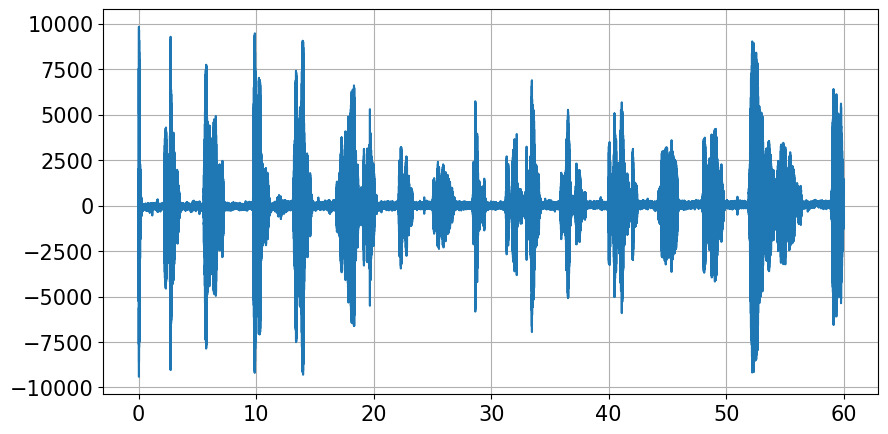
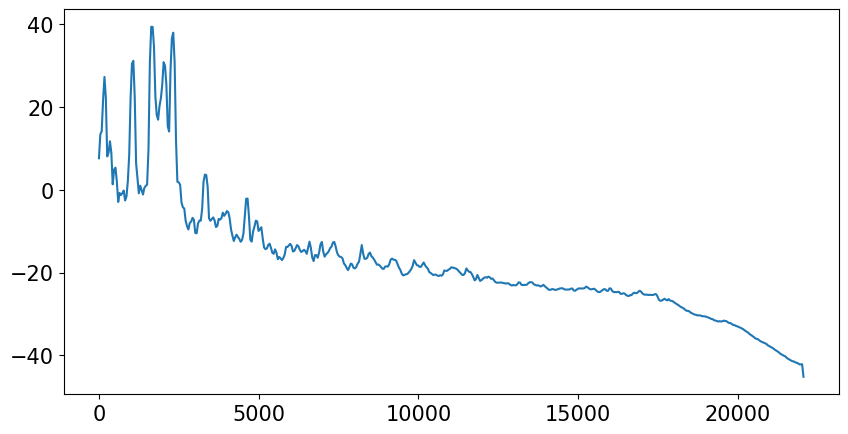
Spectrogram#
xx,nch,fs,cp,sh,vers,SerNum,recTimeStamp = loadData(fileName)
print(nch,fs,cp,sh,vers,SerNum,recTimeStamp)
if (vers>=10) & (vers<20):
scl=2**15
if cp==0:
datx=np.frombuffer(xx[128:],np.int16)
elif cp==1:
datx,td1,td2=getData16(xx)
elif vers>=20:
scl=2**31
if cp==0:
datx=np.frombuffer(xx[128:],np.int32)
elif cp==1:
datx,td1,td2=getData32(xx)
# correct for bias
bias=np.mean(datx)
datx = datx - bias
# time axis
tt=np.arange(len(datx))/fs
dat1=datx
nw=256
nfft=1024
yy=datx/scl
f, t, Zxx = signal.stft(yy, fs,axis=0, nperseg=nw, nfft=nfft)
zz=20*np.log10(np.abs(np.squeeze(Zxx)))
zm=np.max(zz)
[nf,nt]=np.shape(zz)
cm1=plt.cm.jet
cm2=plt.cm.viridis
cm3=mcmap()
cmx=cm3
# prepare plot
fig = plt.figure("figure.figsize",[10,10])
# for time series
ax1 = plt.axes([0.15, 0.71, 0.72, 0.24])
# for spectrogram
ax2 = plt.axes([0.15, 0.09, 0.9, 0.55], sharex=ax1)
# plot time series
p1 = ax1.plot(tt,yy,"k")
ax1.set_xlim(tt[0],tt[-1])
ax1.set_ylabel("Amplitude")
ax1.grid(True)
# plot spectrogram
im = ax2.imshow(zz,
extent=(0,(nt-1)/fs*nw/2,0,fs/2000),
origin='lower', cmap=cmx, clim=(zm-70,zm),
interpolation='nearest', aspect='auto')
ext = im.get_extent()
cbar = plt.colorbar(im, orientation='vertical',ax=ax2)
ax2.set_ylabel("Frequency (kHz)")
ax2.set_xlabel("Time (s)");
plt.show();
1 44100 1 12 20 764542 20230407_1740001
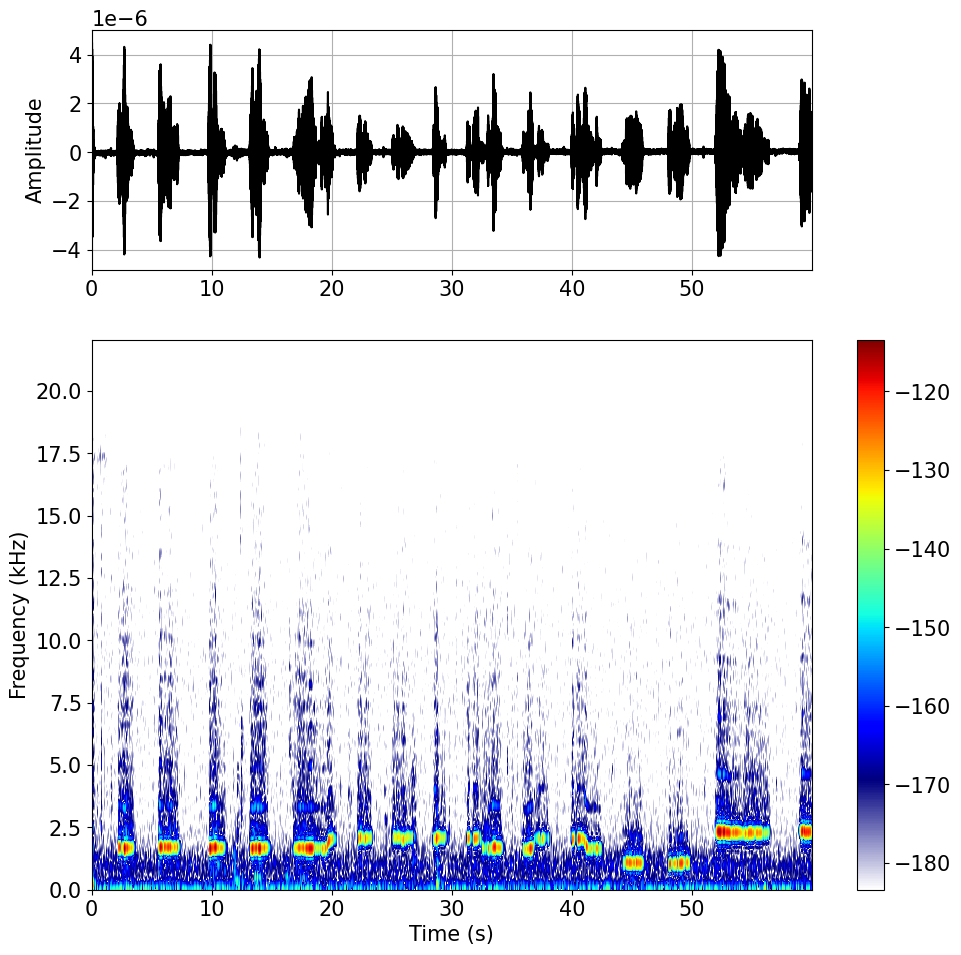
Playing audio data#
# remove # from next line to play sound
#sd.play(yy, 44100)
Visualize file#
import numpy as np
import matplotlib.pyplot as plt
import scipy.signal as signal
import sounddevice as sd
# use local microPAM library
import microPAM_utils as upam
fileName='./data/D0baa7e_20230407/17/F_174000.bin'
dat,ta,to,td1,td2,fs,sh,SerNum=upam.loadAcoustics_o(fileName)
#
# correct for bias
bias=np.mean(dat)
dat = dat - bias
# time axis
tt=np.arange(len(dat))/fs
#
# spectrogram
nw=256
nfft=1024
yy=dat[:,0]
fz, tz, Zxx = signal.stft(yy, fs,axis=0, nperseg=nw, nfft=nfft)
zz=20*np.log10(np.abs(Zxx))
#
# prepare plot
def plot_data(tt,yy,tz,fz,zz):
cm1=plt.cm.jet
cm2=plt.cm.viridis
cm3=upam.mcmap(256)
cmx=cm3
zm=np.max(zz)
#
fig = plt.figure("figure.figsize",[10,10])
# for time series
ax1 = plt.axes([0.15, 0.71, 0.72, 0.24])
# for spectrogram
ax2 = plt.axes([0.15, 0.09, 0.90, 0.55], sharex=ax1)
#
# plot time series
p1 = ax1.plot(tt,yy,"k")
ax1.set_xlim(tt[0],tt[-1])
ax1.set_ylabel("Amplitude")
ax1.grid(True)
#
# plot spectrogram
im = ax2.imshow(zz,
extent=(tz[0],tz[-1],fz[0]/1000,fz[-1]/1000),
origin='lower', cmap=cmx, clim=(zm-70,zm),
interpolation='nearest', aspect='auto')
cbar = plt.colorbar(im, orientation='vertical',ax=ax2)
ax2.set_ylabel("Spectrum (kHz)")
ax2.set_xlabel("Time (s)")
plt.show()
plot_data(tt,yy,tz,fz,zz)
if 0:
sd.play(dat/np.max(datx)/2,fs)
1 44100 1 12 20 764542 20230407_174000first block
C:\Users\zimme\jupyter\microPAM\microPAM_utils.py:331: RuntimeWarning: overflow encountered in scalar subtract
ndx=nd1-nch
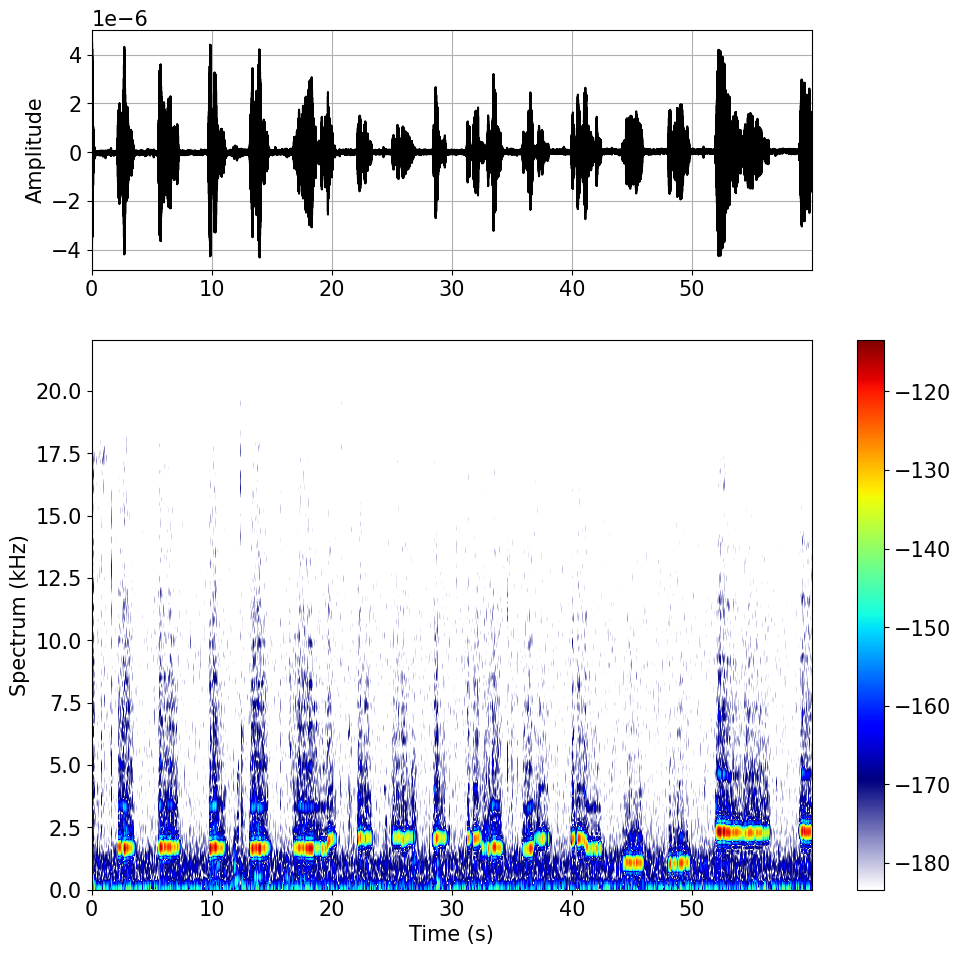
Redesign of ILAC (Integer-Lossless-Acoustic-Compression) decompression#
#
if 1:
fileName='./data/D0baa7e_20230407/17/F_174000.bin'
else:
from tkinter import filedialog
fileName = filedialog.askopenfilename(initialdir="./")
print(fileName)
#
td,dat,fs,SerNum,recTimeStamp=loadAcoustics(fileName)
print(dat.shape,fs,SerNum,recTimeStamp)
dat = dat-dat.mean()
#
nwin = 256
nstep = nwin//2
nfft = 1024
scaling = 'spectrum'
#scaling = 'density'
if 1:
fx,tx,px = spectrogram(dat,fs,nfft,nwin,nstep,scaling)
else:
nw=256
nfft=1024
fx, tx, px = signal.stft(dat, fs,axis=0, nperseg=nw, nfft=nfft)
px=px[:,0,:]
from datetime import datetime
to=td[0]
print(to,'=',datetime.fromtimestamp(to),';',str2seconds(recTimeStamp),'=',recTimeStamp)
import os
fig=plotAcoustics(td,dat,to+tx,fx,px,os.path.basename(fileName))
./data/D0baa7e_20230407/17/F_174000.bin 20 (2644224, 1) 44100 764542 20230407_174000
1680889173.756873 = 2023-04-07 19:39:33.756873 ; 1680882000.0 = 20230407_174000
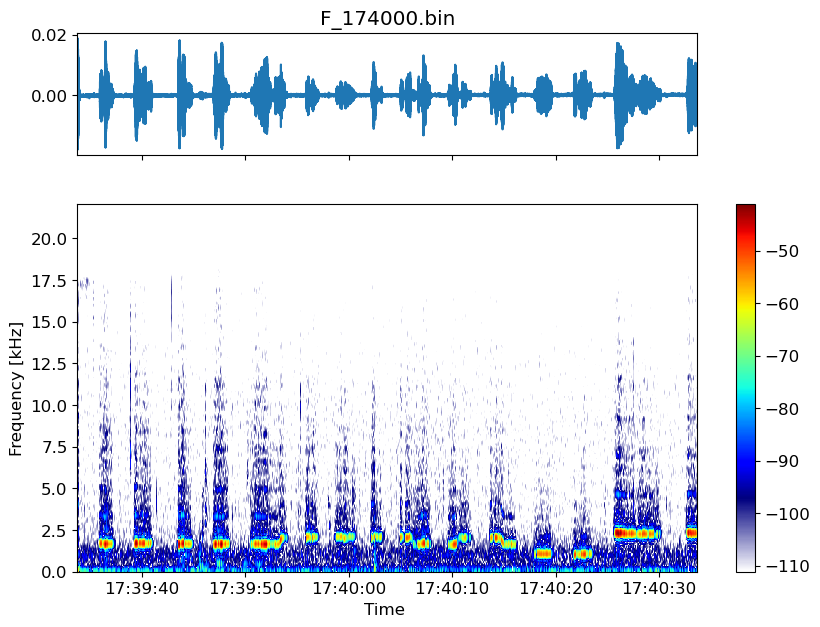
# compare old and new ILAC decompression
plt.plot(np.arange(1000),(dat[:1000]-dat.mean())*2**19) # undue scaling
plt.plot(128+np.arange(1000),dat1[:1000])
plt.show()
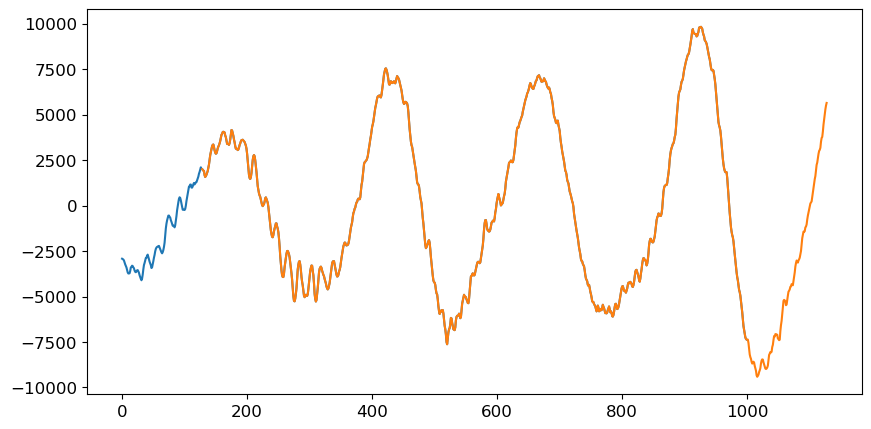
# check wav file headers (original and custom)
fileName='C:\\Users\\zimme\\Desktop\\microPAM\\data\\F20241221_083540.wav'
fileName='C:\\Users\\zimme\\Desktop\\F20241123_142300.wav'
fileName='C:\\Users\\zimme\\Desktop\\3M_ch4_35-40.wav'
xx = np.fromfile(fileName, dtype='uint32',count=128)
print(xx[0].tobytes().decode())
print(xx[1])
print(xx[2].tobytes().decode())
print(xx[3].tobytes().decode())
print(xx[4])
print(xx[9].tobytes().decode())
print(xx[10])
if xx[9].tobytes().decode() == 'info':
print(xx[126].tobytes().decode())
print(xx[127])
RIFF
28800036
WAVE
fmt
16
data
28800000
#decoding 16-bit compressed data
fname='.\\data\\D1382ae_20230308\\12\\F_123903.bin'
xx,nch,fs,cp,sh,vers,SerNum,recTimeStamp=loadData(fname)
print(nch,fs,cp,sh,vers,SerNum,recTimeStamp)
nblock=nch*128
yy=decodeInit(xx,nch,128)
#printHex(yy[:10,:30])
dat2=decode16(yy,nch,128)
dat2=dat2.reshape(-1,nch).astype('float')
print(dat2.shape)
plt.plot(dat2)
plt.show()
1 44100 1 14 10 1278638 20230308_123903(2486016, 1)
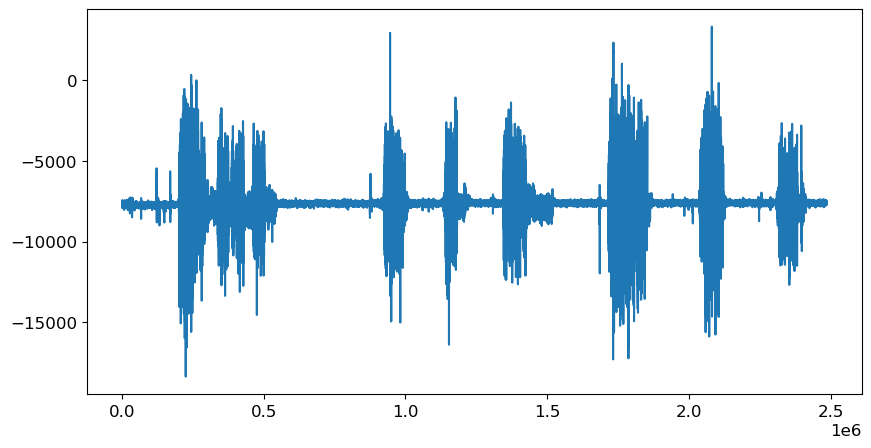
fname='./data/D0baa7e_20230407/17/F_174000.bin'
upam.showAcoustics(fname)
20
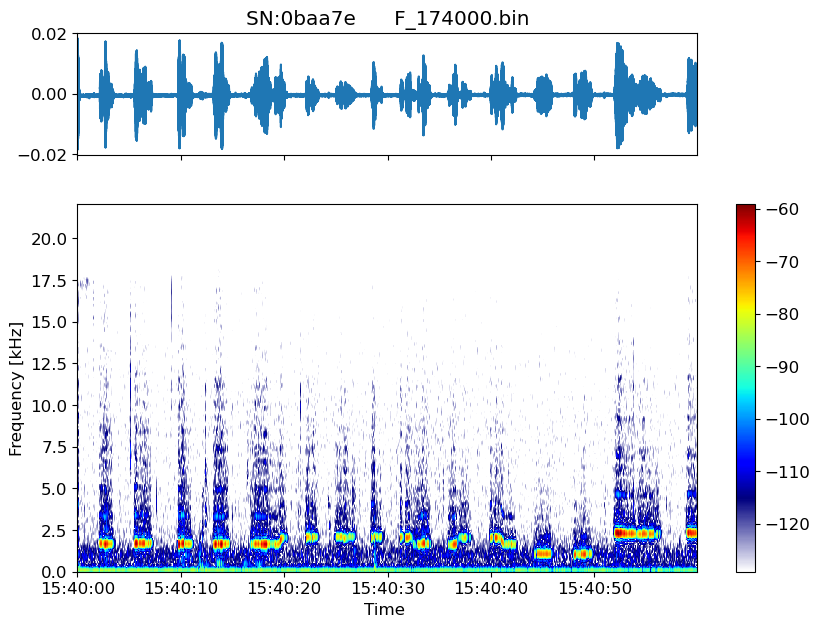
# to play audio
if 0:
fname='./data/D0baa7e_20230407/17/F_174000.bin'
upam.playAcoustics(fname,0.5,0)
# to stop audio if playing
sd.stop()
import microPAM_utils as upam
help(upam.loadAcoustics)
Help on function loadAcoustics in module microPAM_utils:
loadAcoustics(fileName)
load microPAM acoustic data (bin or wav)
td,dat,fs,SerNum,recTimeStamp = loadAcoustics(fileName)
